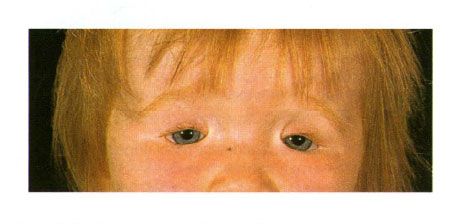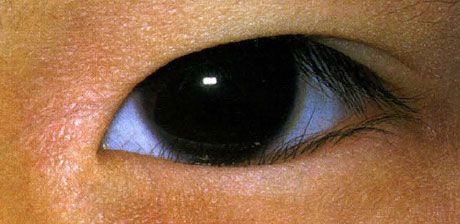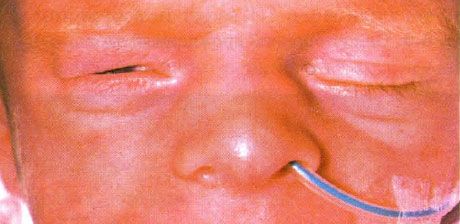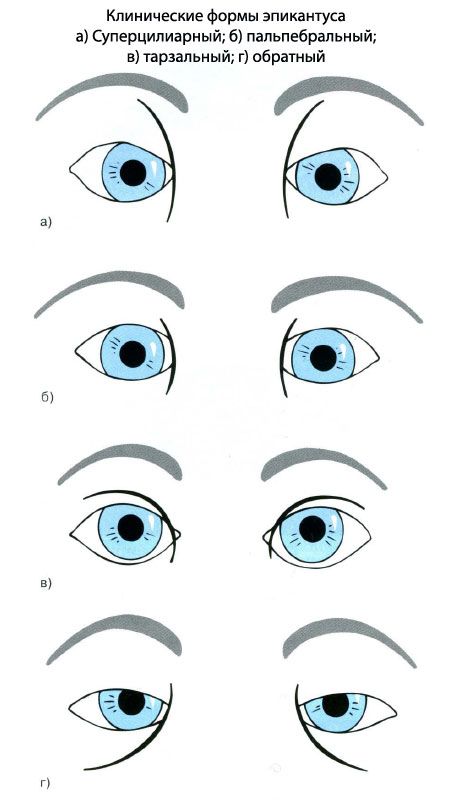Medical expert of the article
New publications
Congenital eyelid anomalies
Last reviewed: 07.07.2025

All iLive content is medically reviewed or fact checked to ensure as much factual accuracy as possible.
We have strict sourcing guidelines and only link to reputable media sites, academic research institutions and, whenever possible, medically peer reviewed studies. Note that the numbers in parentheses ([1], [2], etc.) are clickable links to these studies.
If you feel that any of our content is inaccurate, out-of-date, or otherwise questionable, please select it and press Ctrl + Enter.
I. Cryptophthalmos.
II. Ablepharia:
- complete absence of eyelids;
- absence of eyelids in combination with
- New Laxova syndrome;
- ablepharia syndrome in macrosomia.
III. Coloboma:
- isolated;
- in combination with facial clefts, such as Goldenhar syndrome, Treacher-Collins syndrome;
- In case of severe deformation, the first stage of rehabilitation is surgical correction.

Bilateral coloboma of the eyelids in a child with Goldenar syndrome. Non-closure of the palpebral fissure on the left
IV. Ankyloblepharon:
- fusion of the eyelids;
- narrowing of the palpebral fissure;
- There are forms that are inherited in an autosomal dominant manner.
V. Filiform fusion of the eyelids:
- polyp-like fusion of the upper and lower eyelids, localized in the central sections;
- There are no associated changes in the palpebral fissure.
VI. Brachyblepharon:
- widening of the palpebral fissure;
- There are forms inherited in an autosomal dominant manner;
- may be associated with Down syndrome and craniofacial dysostosis.
VII. Congenital ectropion:
- accompanies:
- blepharophimosis;
- Down syndrome;
- craniofacial syndromes;
- lamellar ichthyosis.
- recommend the use of ointments, tarsorrhaphy or surgical intervention;
- Acute ectropion is called eversion of the eyelid.
VIII. Epiblepharon:
1. folds of skin that run parallel to the edge of the eyelid and cause contact between the eyelashes and the cornea;
- often found among the inhabitants of the East;
- disappears spontaneously, the need for treatment rarely arises;
- In case of associated keratitis, excision of skin folds is recommended, which, as a rule, produces a good effect.

Epiblepharon. Abnormal eyelash growth is present from birth. Sometimes spontaneous improvement occurs.
IX. Entropion:
- pathology associated with microphthalmos;
- occurs when the orbicularis muscle spasms;
- with Larsen syndrome:
- multiple joint dislocations;
- malformations, cleft palate;
- mental retardation;
- Cartilage bending is a congenital horizontal deformation of the eyelid cartilage.

Congenital entropion (inversion). In addition to eyelid pathology, the child has painful eyelids in the right eye. Eyelid swelling is noteworthy. Inversion of the upper eyelid of the right eye with a change in the position of the eyelashes. Despite constant irritation of the cornea, organic changes do not occur at this stage. The situation was normalized by suturing the upper eyelid
Tarsorrhaphy is performed, which has a palliative effect; sometimes there is a need for radical surgical intervention.
X. Epicanthus:
- a vertical fold of skin extending from the upper or lower eyelid toward the medial angle of the eye or extending from the medial angle of the eye in a medial direction;
- often found among the inhabitants of the East;
- pathognomonic sign for blepharophimosis syndrome.

Clinical forms of epicanthus. a) Superciliary, b) palpebral, c) tarsal, d) reverse
XI. Telecanthus:
- increase in the distance between the medial canthus of both eyes;
- If necessary, correction is performed by shortening the ligaments of the medial angle of the eye slit.

Telecanthus and reverse epicanthus
XII. Blepharophimosis (narrowing of the palpebral fissure):
- reduction of the horizontal distance between the eyelids;
- blepharophimosis syndrome:
- ptosis;
- telecanthus;
- blepharophimosis;
- reverse epicanthus is a pathology with an autosomal dominant type of inheritance, in 50% of cases it is sporadic (usually newly occurring mutations), the gene responsible for the occurrence of the disorder is localized in the region 3q22.3-q23.
The disease is often accompanied by strabismus, and affected women may suffer from infertility.
Eyelid retraction in infancy
- Physiological.
- Idiopathic.
- Ipsilateral pseudo-exophthalmos or contralateral ptosis.
- Bilateral disorder, with the "setting sun" symptom against the background of hydrocephalus.
- Marcus Gunn syndrome is a phenomenon of palpebromandibular synkinesis.
- Neonatal Graves' disease.
- Myasthenia gravis.
- Paresis of the third pair of cranial nerves with distorted regeneration.
- Myopathies.
- Paresis of the VII pair of cranial nerves.
- Fibrosis of the levator oculi superioris.
- Vertical nystagmus, against the background of eyelid pathology.
What do need to examine?
How to examine?


 [
[